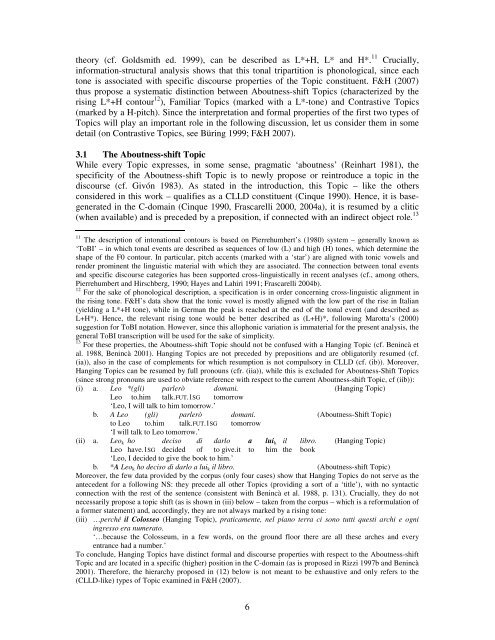Subjects, Topics and the Interpretation of Referential pro.
Subjects, Topics and the Interpretation of Referential pro.
Subjects, Topics and the Interpretation of Referential pro.
Create successful ePaper yourself
Turn your PDF publications into a flip-book with our unique Google optimized e-Paper software.
<strong>the</strong>ory (cf. Goldsmith ed. 1999), can be described as L*+H, L* <strong>and</strong> H*. 11 Crucially,<br />
information-structural analysis shows that this tonal tripartition is phonological, since each<br />
tone is associated with specific discourse <strong>pro</strong>perties <strong>of</strong> <strong>the</strong> Topic constituent. F&H (2007)<br />
thus <strong>pro</strong>pose a systematic distinction between Aboutness-shift <strong>Topics</strong> (characterized by <strong>the</strong><br />
rising L*+H contour 12 ), Familiar <strong>Topics</strong> (marked with a L*-tone) <strong>and</strong> Contrastive <strong>Topics</strong><br />
(marked by a H-pitch). Since <strong>the</strong> interpretation <strong>and</strong> formal <strong>pro</strong>perties <strong>of</strong> <strong>the</strong> first two types <strong>of</strong><br />
<strong>Topics</strong> will play an important role in <strong>the</strong> following discussion, let us consider <strong>the</strong>m in some<br />
detail (on Contrastive <strong>Topics</strong>, see Büring 1999; F&H 2007).<br />
3.1 The Aboutness-shift Topic<br />
While every Topic expresses, in some sense, pragmatic ‘aboutness’ (Reinhart 1981), <strong>the</strong><br />
specificity <strong>of</strong> <strong>the</strong> Aboutness-shift Topic is to newly <strong>pro</strong>pose or reintroduce a topic in <strong>the</strong><br />
discourse (cf. Givón 1983). As stated in <strong>the</strong> introduction, this Topic – like <strong>the</strong> o<strong>the</strong>rs<br />
considered in this work – qualifies as a CLLD constituent (Cinque 1990). Hence, it is basegenerated<br />
in <strong>the</strong> C-domain (Cinque 1990, Frascarelli 2000, 2004a), it is resumed by a clitic<br />
(when available) <strong>and</strong> is preceded by a preposition, if connected with an indirect object role. 13<br />
11 The description <strong>of</strong> intonational contours is based on Pierrehumbert’s (1980) system – generally known as<br />
‘ToBI’ – in which tonal events are described as sequences <strong>of</strong> low (L) <strong>and</strong> high (H) tones, which determine <strong>the</strong><br />
shape <strong>of</strong> <strong>the</strong> F0 contour. In particular, pitch accents (marked with a ‘star’) are aligned with tonic vowels <strong>and</strong><br />
render <strong>pro</strong>minent <strong>the</strong> linguistic material with which <strong>the</strong>y are associated. The connection between tonal events<br />
<strong>and</strong> specific discourse categories has been supported cross-linguistically in recent analyses (cf., among o<strong>the</strong>rs,<br />
Pierrehumbert <strong>and</strong> Hirschberg, 1990; Hayes <strong>and</strong> Lahiri 1991; Frascarelli 2004b).<br />
12 For <strong>the</strong> sake <strong>of</strong> phonological description, a specification is in order concerning cross-linguistic alignment in<br />
<strong>the</strong> rising tone. F&H’s data show that <strong>the</strong> tonic vowel is mostly aligned with <strong>the</strong> low part <strong>of</strong> <strong>the</strong> rise in Italian<br />
(yielding a L*+H tone), while in German <strong>the</strong> peak is reached at <strong>the</strong> end <strong>of</strong> <strong>the</strong> tonal event (<strong>and</strong> described as<br />
L+H*). Hence, <strong>the</strong> relevant rising tone would be better described as (L+H)*, following Marotta’s (2000)<br />
suggestion for ToBI notation. However, since this allophonic variation is immaterial for <strong>the</strong> present analysis, <strong>the</strong><br />
general ToBI transcription will be used for <strong>the</strong> sake <strong>of</strong> simplicity.<br />
13 For <strong>the</strong>se <strong>pro</strong>perties, <strong>the</strong> Aboutness-shift Topic should not be confused with a Hanging Topic (cf. Benincà et<br />
al. 1988, Benincà 2001). Hanging <strong>Topics</strong> are not preceded by prepositions <strong>and</strong> are obligatorily resumed (cf.<br />
(ia)), also in <strong>the</strong> case <strong>of</strong> complements for which resumption is not compulsory in CLLD (cf. (ib)). Moreover,<br />
Hanging <strong>Topics</strong> can be resumed by full <strong>pro</strong>nouns (cfr. (iia)), while this is excluded for Aboutness-Shift <strong>Topics</strong><br />
(since strong <strong>pro</strong>nouns are used to obviate reference with respect to <strong>the</strong> current Aboutness-shift Topic, cf (iib)):<br />
(i) a. Leo *(gli) parlerò domani. (Hanging Topic)<br />
Leo to.him talk.FUT.1SG tomorrow<br />
‘Leo, I will talk to him tomorrow.’<br />
b. A Leo (gli) parlerò domani. (Aboutness-Shift Topic)<br />
to Leo to.him talk.FUT.1SG tomorrow<br />
‘I will talk to Leo tomorrow.’<br />
(ii) a. Leo k ho deciso di darlo a lui k il libro. (Hanging Topic)<br />
Leo have.1SG decided <strong>of</strong> to give.it to him <strong>the</strong> book<br />
‘Leo, I decided to give <strong>the</strong> book to him.’<br />
b. *A Leok ho deciso di darlo a luik il libro. (Aboutness-shift Topic)<br />
Moreover, <strong>the</strong> few data <strong>pro</strong>vided by <strong>the</strong> corpus (only four cases) show that Hanging <strong>Topics</strong> do not serve as <strong>the</strong><br />
antecedent for a following NS: <strong>the</strong>y precede all o<strong>the</strong>r <strong>Topics</strong> (<strong>pro</strong>viding a sort <strong>of</strong> a ‘title’), with no syntactic<br />
connection with <strong>the</strong> rest <strong>of</strong> <strong>the</strong> sentence (consistent with Benincà et al. 1988, p. 131). Crucially, <strong>the</strong>y do not<br />
necessarily <strong>pro</strong>pose a topic shift (as is shown in (iii) below – taken from <strong>the</strong> corpus – which is a reformulation <strong>of</strong><br />
a former statement) <strong>and</strong>, accordingly, <strong>the</strong>y are not always marked by a rising tone:<br />
(iii) …perché il Colosseo (Hanging Topic), praticamente, nel piano terra ci sono tutti questi archi e ogni<br />
ingresso era numerato.<br />
‘…because <strong>the</strong> Colosseum, in a few words, on <strong>the</strong> ground floor <strong>the</strong>re are all <strong>the</strong>se arches <strong>and</strong> every<br />
entrance had a number.’<br />
To conclude, Hanging <strong>Topics</strong> have distinct formal <strong>and</strong> discourse <strong>pro</strong>perties with respect to <strong>the</strong> Aboutness-shift<br />
Topic <strong>and</strong> are located in a specific (higher) position in <strong>the</strong> C-domain (as is <strong>pro</strong>posed in Rizzi 1997b <strong>and</strong> Benincà<br />
2001). Therefore, <strong>the</strong> hierarchy <strong>pro</strong>posed in (12) below is not meant to be exhaustive <strong>and</strong> only refers to <strong>the</strong><br />
(CLLD-like) types <strong>of</strong> Topic examined in F&H (2007).<br />
6
















